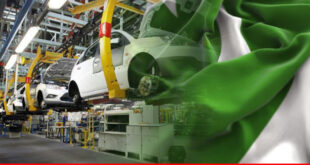Auto & Allied Industry
The automobile industry performed extremely well in 2015 indicating stellar sales and demand growth mostly triggered by overall economic stability and bumper crops in the agriculture sector. This vital sector of the economy, however, it still needs protection in the forthcoming automobile policy with special reference to import of used cars, which is a real threat to local industrial base. Manufacturers as well as vendor industry, which are in fact a job-oriented industry, creating huge number of employment opportunities both directly or indirectly.
The uncertainty, however, surrounding the Auto Industry Development Program II has created ripples in the auto industry as most of stakeholders are shocked at proposed phasing out of most established local brand to benefit inferior quality new entrants.
The experts were critical of statements given by government officials based on anonymity distorting the facts and accusing industry of enjoying protection, producing substandard vehicles and making huge money amid all 3 OEMs being listed companies and the decline in profits being recorded by stock exchanges puzzles the decision makers, the officials doing this activity for fun or vested interest have damaged the government’s efforts to lure in further investments. The fact, experts say, remain that cars are not sold at gun point and the OEMs are accused of charging premium on these substandard vehicles in the same breath by elite of government.
The hype given to the policy by vested interest and unprecedented interest shown by political elite has also surprised the industry experts who believe that discussions upto now and proceedings of different standing committees etc show that the policy is being designed or pushed towards facilitating new investments only whereas the investors eagerly watch the treatment meted out to existing players of the industry.
However, industry experts pointed out that the much delayed AIDP II is reportedly being fine tuned without incorporating most of the recommendations of representative bodies of the original equipment manufacturers or the domestic producers of auto components. The most controversial change proposed in the policy is to stop production of 10-15 years old models.
The basis of the argument is striking as on one hand the government asks the industry to introduce a low priced car for consumers while on the other it is bent upon eliminating the chances of the same, the only car that will be hit through this regime would be Suzuki Mehran – the most marketed and the cheapest car in the market. Moreover it has attained the highest deletion level among the cars being produced in the country.
“It is the only car available in the market that caters to the needs of the lower middle class segment of the society,” said one industry expert. He said motorcyclists graduate from two wheelers to four wheelers by buying this car. The move might have some justification had the government fixed some new standards for below 1000 cc cars, he said. The expert said that it looks that the move has been initiated to provide market to inferior models of below 1000 cc car producers from little known Chinese brands. In the absence of competition from Mehran they would be able to charge higher prices for inferior technology, he said.
He said in a country where the vending industry is operating at 50 per cent capacity withdrawal of its 800 cc car would deprive them of further 30 per cent of the parts market. He said the Chinese assemblers are so small that they are unable even to provide the drawings of the components of their cars.
Another expert said Mehran has been upgraded to Euro II as desired by the regulators and it would be unfair to ban its production after a short time when it upgraded its technology. He said planners should invite reputed manufacturer to enter the small car segment of the Pakistani market instead of promoting obsolete technology from China that are unable to compete in price and performance with the most selling small car of the market. “Even the three years old used cars have not been able to make a dent in the market of Pakistani small car” he added.
Industry experts are at loss to find out the rationale in regularly supporting new entrants with concessions despite their failure to localize simplest of the parts. They said in AIDP I (2007-2012) it was agreed after detailed deliberation that new entrants with annual global production of over 500,000 cars would be provided the concessions in duties for a period of three years after which they would have to match localization done by existing players.
However, they regretted that permission as new entrant was also granted to manufacturers of only 10,000 cars a year by violating the AIDP I document. They said since the new entrants are allowed to import all components at reduced rates in the first year these small producers imported almost completely built units. However since the brands were unknown and vehicles lacked public trust none could market more than 200-300 vehicles in a year. Naturally they failed to convince the local vendors to produce components at such low volumes.
According to the documented evidence provided by these briefcase assemblers even their principals failed to provide drawings of the component that could have facilitated the local manufacturers to produce the part. This implies that even the original manufacturer was getting components in its head office made from vendors for parts made for other vehicles. They wondered how a small foreign manufacturer could facilitate its agents in foreign country to localize components.
The opaque new entrant policy has been looked down by prospective credible car makers while briefcase assemblers are enjoying the new entrant benefits of low duty component imports even after four years of operation.
As per sources different government departments involved in the auto policy i.e. Ministries of Industries, Commerce, Privatization and departments like CCP and EDB are working at cross purpose some of which trumpeting extra protection given to industry during last 25 years whereas on numerous occasion the government has itself deviated from policy, which has actually kept further investments at bay.
A recent demand surfaced by a potential new entrant seeking clarity from government on possible future of used cars prove that new investment is not going to materialize unless the policy is announced and is kept intact for at least next 15 years.
 PAGE Blog Business Weekly Magazine
PAGE Blog Business Weekly Magazine

